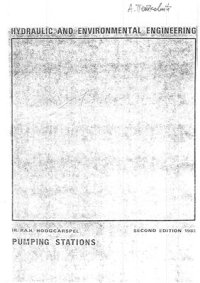
Ebook: Hydraulic and environmental engineering. Pumping Stations
Author: Hoogcarspel.
- Genre: Technique // Construction
- Tags: Промышленное и гражданское строительство, Компрессорное и насосное оборудование, Насосные и компрессорные станции
- Language: English
- pdf
2nd edition. - Ir. P.A.H. Hoogcarspel, 1985. - 138 p.
These notes will discuss the design and appraisal of pumping stations. Generally speaking a pumping station has the purpose of bringing a liquid to a higher lever or pressure or transport it from one point to another. This function is performed by the pump, essential element in a pumping station. The required power be supplied to the pump by driving device (motor/engine) very often through the medium of a transmission. This mechanical equipment is placed in a building, which provides foundation and shelter and system and is often an essential part of the system of inflow conditions, pipelines, etc.). It also houses the electrical and auxiliary equipment.ContentsIncroduction
Main classification of pumps
Pumps with a free water surface
Waterwheel
Archimedean screw
Chain and washerpumps
Positive displacement pumps
Reciprocating positive pumps
Semi-rotary positive pumps
Rotary positive pumps
Character of positive displacement pumps
Injection pumps
Rotodynamic pumps
The propeller or axial flow pump
The mixed flow pump
The centrifugal or radial flow pump
Summary and transitional forms
Higher lifts in multistage pumps
Pumps with double inflow
Normal limits of application for the various lifting devices
Further elaboration of rotodynamic pumps
Pump characteristics and efficiency
Static and manometric head; pipeline or system characteristic
Suction head, cavitation and NPSH
Impeller design, specific speed
Rotodynamic pumps and variation of speed
Rotodynamic pumps with adjustable impeller blades
Variation of impeller diameter
Pumps working in combination
Rotodynamic pumps working in series
Rotodynamic pumps working in parallel
Backflow and max. speed of rotodynamic pumps at backflow
Design of pumping stations
Situation
Mechanical and electrical installations
Construction materials of pumps
Power required; total efficiency
Driving devices
Transmissions
Gates, valves, etc
Electrical installations
Automation and measuring instruments
Auxiliary equipment
Number of pumps to be installed
Position of pumps
Civil engineering aspects
Inflow conditions, air entrainment
Hydraulic aspects
Floating and suspended debris, sand
Sump/ reservoir capacity
Pump installation
Static and dynamic loads
Delivery mains, dike-crossings, syphons
Diameter of pipelines
Pressure waves in pipeline systems
Functions of buildings
Layout of pumping stations
Design procedure
Examples of pumping stations for irrigation and drainage
Small irrigation supply pumps
Additional notes on pumps and special problems in sewage and sludge pumping installations
The liquid. to be pumped
Special provisions related to Pumps, valves, checkvalves, etc
Lifting devices used for sewage or sludge
Boundaries for operation
The interception and/or disintegration of solid matter
Situation of pumps in sewage pumping stations
Additional notes on pumping stations for water distribution
Hand-operated pumps for water supply
Costs
Investment costs
Energy costs
Operating costs
Costs of maintenance and repairs
Cost comparisons
Other criteria for definite choice
Some observations on contract conditions
Literature on pumping stations
Figures
Annex A: Data for preliminary design of Archimedean screw installations
Annex B: Discharges of hydraulic Rams
Annex C: Data required for determination of NPSH
Annex D: Sump capacity
These notes will discuss the design and appraisal of pumping stations. Generally speaking a pumping station has the purpose of bringing a liquid to a higher lever or pressure or transport it from one point to another. This function is performed by the pump, essential element in a pumping station. The required power be supplied to the pump by driving device (motor/engine) very often through the medium of a transmission. This mechanical equipment is placed in a building, which provides foundation and shelter and system and is often an essential part of the system of inflow conditions, pipelines, etc.). It also houses the electrical and auxiliary equipment.ContentsIncroduction
Main classification of pumps
Pumps with a free water surface
Waterwheel
Archimedean screw
Chain and washerpumps
Positive displacement pumps
Reciprocating positive pumps
Semi-rotary positive pumps
Rotary positive pumps
Character of positive displacement pumps
Injection pumps
Rotodynamic pumps
The propeller or axial flow pump
The mixed flow pump
The centrifugal or radial flow pump
Summary and transitional forms
Higher lifts in multistage pumps
Pumps with double inflow
Normal limits of application for the various lifting devices
Further elaboration of rotodynamic pumps
Pump characteristics and efficiency
Static and manometric head; pipeline or system characteristic
Suction head, cavitation and NPSH
Impeller design, specific speed
Rotodynamic pumps and variation of speed
Rotodynamic pumps with adjustable impeller blades
Variation of impeller diameter
Pumps working in combination
Rotodynamic pumps working in series
Rotodynamic pumps working in parallel
Backflow and max. speed of rotodynamic pumps at backflow
Design of pumping stations
Situation
Mechanical and electrical installations
Construction materials of pumps
Power required; total efficiency
Driving devices
Transmissions
Gates, valves, etc
Electrical installations
Automation and measuring instruments
Auxiliary equipment
Number of pumps to be installed
Position of pumps
Civil engineering aspects
Inflow conditions, air entrainment
Hydraulic aspects
Floating and suspended debris, sand
Sump/ reservoir capacity
Pump installation
Static and dynamic loads
Delivery mains, dike-crossings, syphons
Diameter of pipelines
Pressure waves in pipeline systems
Functions of buildings
Layout of pumping stations
Design procedure
Examples of pumping stations for irrigation and drainage
Small irrigation supply pumps
Additional notes on pumps and special problems in sewage and sludge pumping installations
The liquid. to be pumped
Special provisions related to Pumps, valves, checkvalves, etc
Lifting devices used for sewage or sludge
Boundaries for operation
The interception and/or disintegration of solid matter
Situation of pumps in sewage pumping stations
Additional notes on pumping stations for water distribution
Hand-operated pumps for water supply
Costs
Investment costs
Energy costs
Operating costs
Costs of maintenance and repairs
Cost comparisons
Other criteria for definite choice
Some observations on contract conditions
Literature on pumping stations
Figures
Annex A: Data for preliminary design of Archimedean screw installations
Annex B: Discharges of hydraulic Rams
Annex C: Data required for determination of NPSH
Annex D: Sump capacity
Download the book Hydraulic and environmental engineering. Pumping Stations for free or read online
Continue reading on any device:

Last viewed books
Related books
{related-news}
Comments (0)